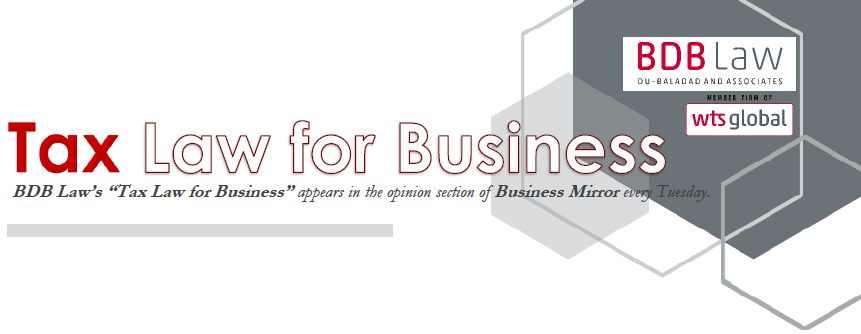
Transfer Pricing Pitfalls and Concerns
By Atty. Irwin C. Nidea Jr.
"Taxpayer must make sure that its transfer pricing documentation will convince the BIR that the correct comparables and the correct method were used."
Transfer pricing is now in the consciousness of many Philippine companies. After the issuance of Revenue Regulation 2-2013 seven years ago, a new revenue circular now makes it mandatory to prepare a contemporaneous transfer pricing documentation. On top of that, the BIR also requires the submission of BIR Form 1709. This BIR Form will be used as a reference in choosing which company will be subjected to transfer pricing investigation by the BIR.
Since transfer pricing is new to many taxpayers, it is important to understand the common pitfalls and red flags that must be avoided to shield a company from audit. Especially now that the BIR will be issuing letters of authority (LOA) to investigate, exclusively for transfer pricing audit.
 First, a conglomerate must identify its related party transactions that pose significant risk. Since these companies know their business better than any external advisor, they are in the best position to determine the list of material inter-company transactions according to amount and impact. They are also in the best position to know whether there is an internal transfer pricing policy that is currently being used and whether this is being followed. For example, is there a significant discrepancy in the expenses charged to an affiliate that enjoys a tax holiday compared to affiliates that does not? It is possible that to maximize the tax holiday of a company, all its expenses are shifted to other affiliates that do not have the same privilege. In this scheme, the whole group will be able to maximize these expenses as deduction to tax. Taxpayers must be aware that the BIR will focus on large claims of income as well as large claims of losses.
First, a conglomerate must identify its related party transactions that pose significant risk. Since these companies know their business better than any external advisor, they are in the best position to determine the list of material inter-company transactions according to amount and impact. They are also in the best position to know whether there is an internal transfer pricing policy that is currently being used and whether this is being followed. For example, is there a significant discrepancy in the expenses charged to an affiliate that enjoys a tax holiday compared to affiliates that does not? It is possible that to maximize the tax holiday of a company, all its expenses are shifted to other affiliates that do not have the same privilege. In this scheme, the whole group will be able to maximize these expenses as deduction to tax. Taxpayers must be aware that the BIR will focus on large claims of income as well as large claims of losses.
Another danger area is determining the acceptable comparable and database for the BIR. There are many databases available to taxpayers. But what will the BIR use as its own database? Should taxpayers focus on local comparables? There are also different methods used to prove arm’s length intercompany pricing as prescribed by the OECD, i.e., Comparable Uncontrolled Price (CUP) Method, Transactional net margin method (TNMM), among others. What is the BIR’s preference among these methods? These are potential sources of conflict with the BIR.
It must be noted that the Philippines is not a signatory to the OECD. But Revenue Regulations 2-2013 is derived from it. Comparability and method selection issues are usually the bone of contention in an audit. It would be better if taxpayers know the BIR’s preference at this time. But since there are no precedents yet in our jurisdiction, comparability and method selection issues can have significant part in transfer pricing audit and litigation. Taxpayers must make sure that their transfer pricing documentation will convince the BIR that the correct comparables and the correct method were used.
It is also important to remember that the BIR requires not only a transfer pricing study but the supporting documents as well. The BIR will scrutinize these supporting documents which usually include inter-company contracts that define the functions, risks and benefits of each party. Currently, I have observed that many inter-company transactions are only documented through invoice, debit or credit memo. This practice must end. All related party transactions are now required to have written agreements.
The BIR’s goal is tax compliance. But it must also help and unburden taxpayers from unnecessary requirements and impossible timelines.
First, there is no threshold amount as to what types of taxpayers are required to submit a transfer pricing documentation. Thus, small and medium enterprises (SMEs) are required to submit the same transfer pricing compliance as multinational corporations. The absence of threshold must be given a second look. It is an additional cost that SMEs must be exempted from.
Also, the deadline given to companies to submit their transfer pricing documentation is too tight, particularly to those who are required to submit their BIR Form 1709 on September 30, 2020. The revenue circular was only released around a month ago and the transfer pricing documentation compliance that it requires is not an easy task. The BIR must seriously consider extending the deadline of these companies.
As the BIR tries to catch up with the world in transfer pricing compliance, it must not unnecessarily burden small companies who are not their target anyway. It must also be fair in terms of timelines and documentation. Taxpayers must also prepare an air-tight transfer pricing documentation to avoid the risk of an audit adjustment.
The author is a senior partner of Du-Baladad and Associates Law Offices, a member-firm of WTS Global.
The article is for general information only and is not intended, nor should be construed as a substitute for tax, legal or financial advice on any specific matter. Applicability of this article to any actual or particular tax or legal issue should be supported therefore by a professional study or advice. If you have any comments or questions concerning the article, you may e-mail the author at This email address is being protected from spambots. You need JavaScript enabled to view it. or call 8403-2001 local 330.



